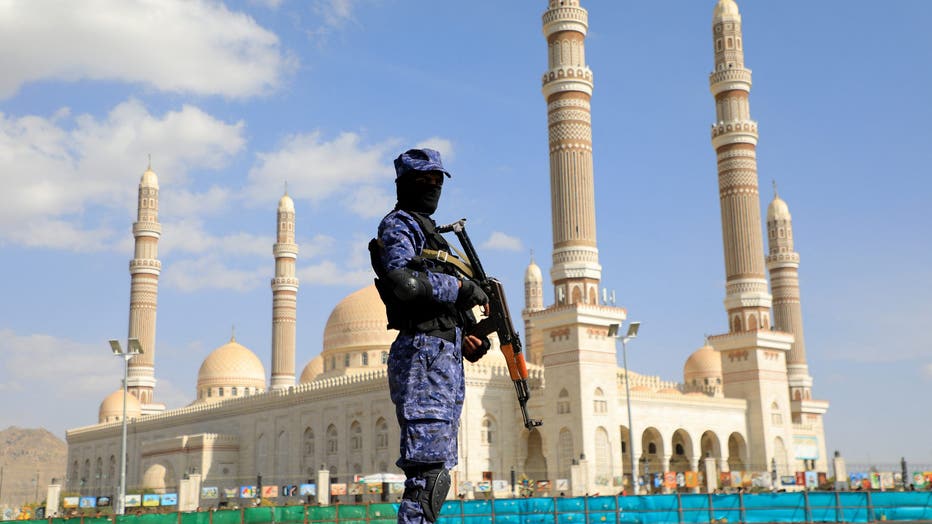Who are the Houthi rebels and why is the US targeting them?
Houthi attack military plans accidently leaked
The Atlantic's editor-in-chief was inadvertently included on a messaging chain of senior Trump officials that discussed plans for a forthcoming strike on the Houthis in Yemen.
LOS ANGELES - The Houthi rebels have gone from a regional faction in Yemen to a globally known militant group. Backed by Iran and fueled by anti-Western sentiment, they’ve launched attacks on ships, struck Israel with drones, and are now facing intensified U.S. airstrikes ordered by President Donald Trump.
Their growing military capabilities and political influence have made them a central player in the Middle East.
Here’s a deeper look at who they are and why they matter.
Where did the Houthis come from?
The backstory:
The Houthis emerged in the early 1990s as a revivalist movement among Yemen’s Zaydi Shiite minority. Their official name is Ansar Allah, or "Supporters of God." By 2014, they had grown powerful enough to overthrow Yemen’s internationally recognized government and seize the capital, Sanaa.
What began as a local insurgency quickly turned into a wider civil war. The conflict escalated in 2015 when a Saudi-led coalition, backed by the U.S., intervened in support of Yemen’s ousted government. The Houthis, backed by Iran, have held their ground ever since.
Why is the U.S. targeting them now?
What's next:
The Houthis began targeting commercial ships in the Red Sea following the October 7 Hamas attack on Israel. Using drones and missiles, they struck over 100 vessels, killing four sailors and sinking two ships.
The attacks disrupted global shipping routes and prompted the U.S. and U.K. to begin joint airstrikes in early 2024.

FILE - A Houthi fighter stands guard in front of Sanaa's Al-Saleh Grand Mosque in Yemen. (Photo by MOHAMMED HUWAIS/AFP via Getty Images)
Under President Trump, those airstrikes have dramatically escalated. The new campaign targets not only Houthi launch sites but also senior personnel and suspected intelligence hubs. Trump has vowed to continue strikes until the Houthis are "no longer capable of threatening global shipping."
What do the Houthis want?
Big picture view:
The Houthis say they’re fighting to resist U.S. and Israeli influence in the region and to support Palestinians in Gaza. They also want to cement their control of northern Yemen and gain international legitimacy.
But analysts say their attacks are also a way to distract from economic hardship and human rights abuses at home. The group has cracked down on dissent and aid workers, even as millions of Yemenis face food insecurity and lack of medical care.
How is Iran involved?
The other side:
The Houthis are widely believed to be part of Iran’s so-called "Axis of Resistance," a network of militant groups that includes Hezbollah in Lebanon and Hamas in Gaza.
U.S. warships shoot down Houthi drones
JINSA's Blaise Misztal joins LiveNOW's Andy Mac to discuss the latest on President Trump ordering U.S. strikes on Houthi rebels in Yemen.
Iran denies directly arming the Houthis, but U.S. officials and independent experts have repeatedly linked seized weapons and drone components back to Iran. American officials have warned Tehran that further attacks by the Houthis will be viewed as actions emanating from Iran.
How much damage have the Houthis done?
By the numbers:
Since late 2023, the Houthis have significantly disrupted global shipping routes and regional stability through a series of drone and missile attacks.
- 100+ ships attacked in Red Sea since late 2023
- 2 commercial vessels sunk, 4 sailors killed
- 61 Houthi deaths reported in recent U.S. airstrikes
- 260+ previous strikes under Biden administration, per IISS
- 1 U.S. drone downed in March 2025
Where is the fighting going?
Local perspective:
The Houthis have said they will resume attacks on "Israeli" ships and continue to oppose Western military presence. In turn, the U.S. has expanded its list of Houthi targets and re-designated the group as a terrorist organization.
Trump’s advisors say Iranian ships, military trainers, and intelligence sites in the region are now "on the table" for potential strikes. Analysts warn that Gulf states and global oil markets could also become targets.
Signal app leak draws scrutiny amid airstrikes
Dig deeper:
Recently, a leaked group chat between Trump national security officials discussing strike plans — via the Signal app — brought renewed scrutiny to the administration’s handling of sensitive information. Read the full story on the Signal chat scandal here.
The Source: This article is based on multiple reports from The Associated Press and Axios, including AP coverage published March 17, March 29, and Axios coverage from March 26, 2025. All casualty figures, quotes, and policy statements are drawn directly from those reports.

